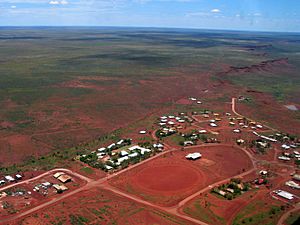Topsy Gibson Napaltjarri facts for kids
Quick facts for kids
Topsy Gibson Napaltjarri
|
|
|---|---|
| Born | c.1950 Wirrulnga, near Kiwirrkurra Community, Western Australia
|
| Nationality | Australian |
| Known for | Painting |
Topsy Gibson Napaltjarri (born around 1950), also known as Tjayika or Tjanika, is an Indigenous artist. She speaks the Pintupi language. Topsy comes from the Western Desert area of Australia.
Contents
About Topsy Gibson Napaltjarri
Topsy Gibson was born around 1950. Her birthplace was Wirrulnga, which is near the Kiwirrkurra Community, Western Australia. She was the first child of Papalya Nangala and Waku Tjungurrayi. The exact year of her birth is not known. This is because Indigenous Australians sometimes measure time differently. They might estimate dates by comparing them to other important events.
What is a Skin Name?
Her name includes 'Napaltjarri'. This is a special 'skin name' used by Indigenous people in central Australia. There are sixteen different skin names. They help show how people are related to each other. These names also guide who people can marry. They can be linked to special animal or plant symbols called totems. People might use these names to address each other. However, they are not like surnames that Europeans use. So, 'Topsy Gibson' is the part of her name that belongs only to her.
Topsy's Family and Life
Topsy Gibson married Tommy Tjakamarra. They first lived at Mount Doreen, which is north-west of Yuendumu, Northern Territory. Later, they moved to Yuendumu and then to Papunya. She later married Tony Tjakamarra. They moved to Balgo, Western Australia. In 1984, they settled in Kiwirrkurra. Topsy has a son. She also has two daughters, Yalamay, born in 1973, and Lynette, born in 1976. Topsy Gibson helps manage the land in the Kiwirrkurra Area. She is a member of the Tjamu Tjamu Aboriginal Corporation.
Topsy Gibson's Art
How Indigenous Art Began
Modern Indigenous art from the Western Desert started in 1971. Indigenous men in Papunya began painting with help from a teacher, Geoffrey Bardon. They used acrylic paints to create designs. These designs were like those used in body painting and ground sculptures. This new art quickly spread across Indigenous communities. A government art program in central Australia started in 1983. This helped the art become even more popular. By the 1980s and 1990s, this art was shown all over the world.
At first, only men were painting. The men from the Pintupi group were not keen on women painting. But many women wanted to paint too. In the 1990s, many Indigenous women started creating paintings. In places like Kintore, Yuendumu, and Balgo, people began making art to show and sell.
Topsy's Artistic Journey
Topsy Gibson started painting in 1996. Her sister, Takariya, also began painting that year. Her younger brother, Warlimirrnga Tjapaltjarri, had started painting earlier, in 1987. Topsy's art is shown by Warlayirti Artists. This is an Indigenous art centre in Balgo, Western Australia.
Western Desert artists often paint specific 'dreamings'. These are special stories or designs that they have the right to paint. For Topsy, her stories include the Snake Dreaming. She also paints the Minyma Kutjarra, which means 'Two Women' Dreaming.


